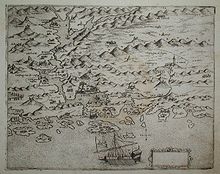St. Nicholas Fortress: Difference between revisions
removed Category:1546 establishments in Europe; added Category:1547 establishments in Europe using HotCat |
J3Y B6xE5aY (talk | contribs) m Added a more precise location information. |
||
| Line 30: | Line 30: | ||
Only St. Nicholas Fortress is at sea, at the entrance of Šibenik port, and the other three are on land. |
Only St. Nicholas Fortress is at sea, at the entrance of Šibenik port, and the other three are on land. |
||
St. Nicholas Fortress was built on the left side at the entrance of the [[Anthony the Great|St. Anthony]] ''(Sv. Ante)'' channel, on the island called ''Ljuljevac'' |
St. Nicholas Fortress was built on the left side at the entrance of the [[Anthony the Great|St. Anthony]] ''(Sv. Ante)'' channel, on the island called ''Ljuljevac''. The island is at the entrance of Šibenik channel across from the [[Jadrija]] beach lighthouse. St. Nicholas Fortress got its name from the [[Benedictine]] Monastery of [[St. Nicholas]], which was on the island, but due to construction of the fortress had to be demolished. At the request of domestic [[Croat]] population of Šibenik, the [[Venice|Venetian]] captain Alojzije de Canal decided to build a fort on an island of Ljuljevac on 30 April 1525. Fortress was designed and built by the famous Venetian [[architect]] and builder Hyeronimus di San Michaela. It was built by in the 16th century to prevent [[Ottoman Empire|Turkish]] boats from reaching the port. St. Nicholas Fortress was armed with 32 [[cannon]]. However, its imposing appearance and size were a bigger threat to the enemy than canons. |
||
==Architecture== |
==Architecture== |
||
| Line 46: | Line 46: | ||
==See also== |
==See also== |
||
*[[Šibenik]] |
*[[Šibenik]] |
||
*[[Jadrija]] |
|||
==References== |
==References== |
||
Revision as of 14:57, 12 April 2016
| St. Nicholas Fortress Tvrđava Sv. Nikole | |
|---|---|
| Šibenik Croatia | |
 | |
| Type | Fortress |
| Site information | |
| Owner | Šibenik, Croatia |
| Controlled by | Republic of Venice |
| Open to the public | Yes |
| Condition | Preserved |
| Site history | |
| Built | 1540.-1547. |
| Built by | Hyeronimus di San Michaela |
| Materials | Limestone |
St. Nicholas Fortress (Croatian: Tvrđava Sv. Nikole) is a fortress located in the town of Šibenik, one of the oldest native Croatian towns on the eastern shores of the Adriatic, in central Dalmatia, Croatia.
History
In the town of Šibenik there are four fortresses:
- St. Nicholas Fortress (Tvrđava Sv. Nikole)
- St. Michael Fortress (Tvrđava Sv. Mihovila)
- St. John Fortress (Tvrđava Sv. Ivana)
- Šubićevac Fortress
Only St. Nicholas Fortress is at sea, at the entrance of Šibenik port, and the other three are on land.
St. Nicholas Fortress was built on the left side at the entrance of the St. Anthony (Sv. Ante) channel, on the island called Ljuljevac. The island is at the entrance of Šibenik channel across from the Jadrija beach lighthouse. St. Nicholas Fortress got its name from the Benedictine Monastery of St. Nicholas, which was on the island, but due to construction of the fortress had to be demolished. At the request of domestic Croat population of Šibenik, the Venetian captain Alojzije de Canal decided to build a fort on an island of Ljuljevac on 30 April 1525. Fortress was designed and built by the famous Venetian architect and builder Hyeronimus di San Michaela. It was built by in the 16th century to prevent Turkish boats from reaching the port. St. Nicholas Fortress was armed with 32 cannon. However, its imposing appearance and size were a bigger threat to the enemy than canons.
Architecture

The fortress is one of the most valuable and best preserved examples of defense architecture in Dalmatia. The fortress is made of brick because this material was considered to be most resistant to cannonballs, while the foundations are made of stone. Although defense capabilities of the fortress have never been tested in military operations, the structure still proved successful in protecting the city from sea-bound enemy attacks. During the centuries of use, the structure served to various armies and has undergone a number of renovations, some of them made necessary because of the development of arms. It was completely abandoned by the military in 1979 and has been in renovation ever since.
-
Footpath towards fortress
-
St. Nicholas Fortress interior
-
St. Nicholas Fortress upper structure
Notes
In the Mediterranean, there are two similar forts: one on the island of Malta, and the other is in Venice; its name is Saint Nicholas.





